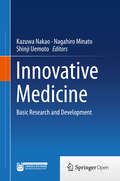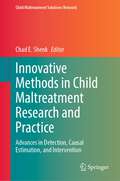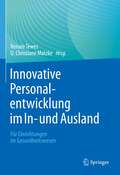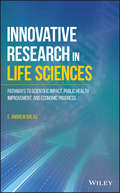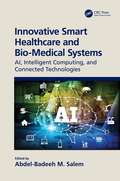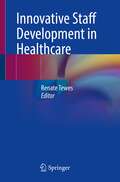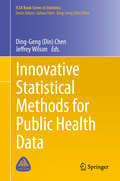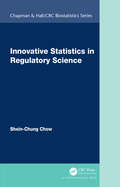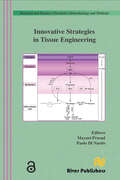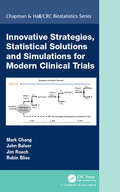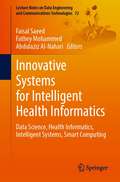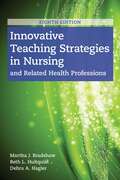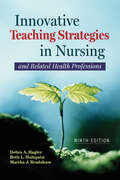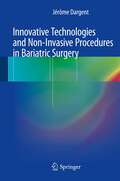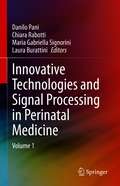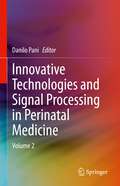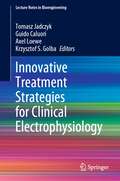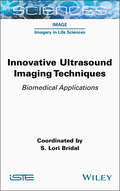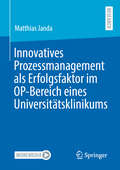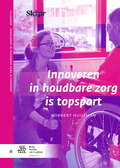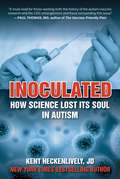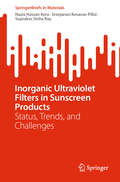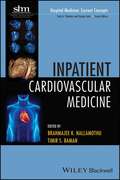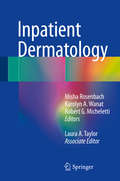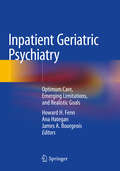- Table View
- List View
Innovative Medicine
by Kazuwa Nakao Nagahiro Minato Shinji UemotoThis book is devoted to innovative medicine, comprising the proceedings of the Uehara Memorial Foundation Symposium 2014. It remains extremely rare for the findings of basic research to be developed into clinical applications, and it takes a long time for the process to be achieved. The task of advancing the development of basic research into clinical reality lies with translational science, yet the field seems to struggle to find a way to move forward. To create innovative medical technology, many steps need to be taken: development and analysis of optimal animal models of human diseases, elucidation of genomic and epidemiological data, and establishment of "proof of concept". There is also considerable demand for progress in drug research, new surgical procedures, and new clinical devices and equipment. While the original research target may be rare diseases, it is also important to apply those findings more broadly to common diseases. The book covers a wide range of topics and is organized into three complementary parts. The first part is basic research for innovative medicine, the second is translational research for innovative medicine, and the third is new technology for innovative medicine. This book helps to understand innovative medicine and to make progress in its realization.
Innovative Methods in Child Maltreatment Research and Practice: Advances in Detection, Causal Estimation, and Intervention (Child Maltreatment Solutions Network)
by Chad E. ShenkThis book examines the latest methodological advancements in child maltreatment research and practice. It addresses long-standing challenges when working with and serving the child maltreatment population, while offering pragmatic solutions for scientists, caseworkers, and providers. Chapters explore methodological innovations in such areas as screening and detecting child maltreatment, collecting objective data in longitudinal research, causal modeling of adverse health effects, and advancements in both preventive and clinical interventions.Key areas of coverage include methods for: Screening for child maltreatment at the point of contact.Reducing bias and promoting causal inference when examining health effects and etiological processes.Promoting representative samples, objective data collection, and integration of child welfare and medical records to enhance equitable access to care.Intervening with children and families at risk for and exposed to maltreatment. Innovative Methods in Child Maltreatment Research and Practice is a must-have reference for researchers, professors, and graduate students as well as clinicians, therapists, and other professionals in developmental, clinical child, and school psychology.
Innovative Personalentwicklung im In- und Ausland: Für Einrichtungen im Gesundheitswesen
by Renate Tewes U. Christiane MatzkePersonalentwicklung ist ein wichtiger Baustein für eine nachhaltige Mitarbeiterstruktur in Pflege- und Gesundheitseinrichtungen. Diese Buch bietet Personalverantwortlichen einen Blick über den nationalen Tellerrand und zeigt inovatibe Konzepte aus dem In- und Ausland.
Innovative Research in Life Sciences: Pathways to Scientific Impact, Public Health Improvement, and Economic Progress
by E. Andrew Balas“I thoroughly enjoyed reading this book as it has taken me on a journey through time, across the globe and through multiple disciplines. Indeed, we need to be thinking about these concepts and applying them every day to do our jobs better.” Farah Magrabi, Macquarie University, Australia “The reader will find intriguing not only the title but also the content of the book. I’m also pleased that public health, and even more specifically epidemiology has an important place in this ambitious discussion.” Elena Andresen, Oregon Health & Science University, USA “This book is very well written and addresses an important topic. It presents many reasons why basic scientists/researchers should establish collaborations and access information outside traditional means and not limit thinking but rather expand such and perhaps develop more innovative and translational research ventures that will advance science and not move it laterally.” Gerald Pepe, Eastern Virginia Medical School, USA “This book gathers logically and presents interestingly (with many examples) the qualities and attitudes a researcher must possess in order to become successful. On the long run, the deep and carefully reexamined research will be the one that lasts.” Zoltán Néda, Babeş-Bolyai University, Romania “I really liked the five pillars delineating the components of humanism in research. This book has made a major contribution to the research ethics literature.” David Fleming, University of Missouri, USA A comprehensive review of the research phase of life sciences from design to discovery with suggestions to improve innovation This vital resource explores the creative processes leading to biomedical innovation, identifies the obstacles and best practices of innovative laboratories, and supports the production of effective science. Innovative Research in Life Sciences draws on lessons from 400 award-winning scientists and research from leading universities. The book explores the innovative process in life sciences and puts the focus on how great ideas are born and become landmark scientific discoveries. The text provides a unique resource for developing professional competencies and applied skills of life sciences researchers. The book examines what happens before the scientific paper is submitted for publication or the innovation becomes legally protected. This phase is the most neglected but most exciting in the process of scientific creativity and innovation. The author identifies twelve competencies of innovative biomedical researchers that described and analyzed. This important resource: Highlights the research phase from design to discovery that precedes innovation disclosure Offers a step by step explanation of how to improve innovation Offers solutions for improving research and innovation productivity in the life sciences Contains a variety of statistical databases and a vast number of stories about individual discoveries Includes a process of published studies and national statistics of biomedical research and reviews the performance of research labs and academic institutions Written for academics and researchers in biomedicine, pharmaceutical science, life sciences, drug discovery, pharmacology, Innovative Research in Life Sciences offers a guide to the creative processes leading to biomedical innovation and identifies the best practices of innovative scientists and laboratories.
Innovative Smart Healthcare and Bio-Medical Systems: AI, Intelligent Computing and Connected Technologies
by Salem, Abdel-Badeeh M.Advances in smart healthcare systems (SHS) and artificial intelligence (AI) domains highlight the need for ICT systems that aim not only to improve human quality of life but improve safety too. SHS bring together concepts and methodologies from various fields, such as communications and network systems, computer science, life sciences and healthcare. The well-known smart healthcare paradigms are; real-time monitoring devices, computer-aided surgery devices, telemedicine devices, population-based care devices, personalized medicine from a machine learning perspective, ubiquities intelligent computing, expert decision support systems, Health 2.0 and Internet of Things (IoT). This book presents models for the deployment of intelligent computing, information, and networking technologies to aid in preventing disease, improving the quality of care and lowering overall cost. It also discusses the potential role of the AI paradigms, computational intelligence and machine learning techniques which are used in developing the SHS. It will provide examples of potential usage of such technology in smart healthcare and and bio-medical systems. It will be an important read for researchers and professionals working in smart healthcare systems, as well as those working in the individual areas of networks, artificial intelligence and healthcare who want to see how an interdisciplinary approach can enhance the current technology.
Innovative Staff Development in Healthcare
by Renate TewesThis book explains how staff development is an important element for a sustainable staff structure health care facilities. At the end each chapter the reader finds a to-do-list, to replicate the project. The book is devided into 4 parts: 1. Practicing culture change, 2. Learning emotional intelligence, 3. Establishing interprofessional collaboration and 4. How to create the future of healthcare. Anticipating these options and experiences will help leaders to inspire their teams with practical ideas.To find the right trainings for staff development can be time consuming. With this overview about international successful projects the reader has an update about innovations in healthcare and uses the knowledge for the reader's own team or healthcare institution. This book helps readers experiencing their own culture change in their organisation, and create the future of their team or facility with knowledge about how to develop a person-centred culture, how to implement the TeamProcessPerformance in their operation theatre, how to reduce stress by using simple HeartMath-methods. This book also informs on how to establish wellbeing at the workplace, and how to practice interprofessional collaboration to reduce mistakes and costs. Written by authors from UK, Turkey, USA, Scotland, Ireland and Germany, this book offers human resource managers a look beyond their national horizon and presents innovative international concepts.
Innovative Statistical Methods for Public Health Data
by Ding-Geng Din Chen Jeffrey WilsonThe book brings together experts working in public health and multi-disciplinary areas to present recent issues in statistical methodological development and their applications. This timely book will impact model development and data analyses of public health research across a wide spectrum of analysis. Data and software used in the studies are available for the reader to replicate the models and outcomes. The fifteen chapters range in focus from techniques for dealing with missing data with Bayesian estimation, health surveillance and population definition and implications in applied latent class analysis, to multiple comparison and meta-analysis in public health data. Researchers in biomedical and public health research will find this book to be a useful reference and it can be used in graduate level classes.
Innovative Statistics in Regulatory Science (Chapman & Hall/CRC Biostatistics Series)
by Shein-Chung ChowStatistical methods that are commonly used in the review and approval process of regulatory submissions are usually referred to as statistics in regulatory science or regulatory statistics. In a broader sense, statistics in regulatory science can be defined as valid statistics that are employed in the review and approval process of regulatory submissions of pharmaceutical products. In addition, statistics in regulatory science are involved with the development of regulatory policy, guidance, and regulatory critical clinical initiatives related research. This book is devoted to the discussion of statistics in regulatory science for pharmaceutical development. It covers practical issues that are commonly encountered in regulatory science of pharmaceutical research and development including topics related to research activities, review of regulatory submissions, recent critical clinical initiatives, and policy/guidance development in regulatory science. Devoted entirely to discussing statistics in regulatory science for pharmaceutical development. Reviews critical issues (e.g., endpoint/margin selection and complex innovative design such as adaptive trial design) in the pharmaceutical development and regulatory approval process. Clarifies controversial statistical issues (e.g., hypothesis testing versus confidence interval approach, missing data/estimands, multiplicity, and Bayesian design and approach) in review/approval of regulatory submissions. Proposes innovative thinking regarding study designs and statistical methods (e.g., n-of-1 trial design, adaptive trial design, and probability monitoring procedure for sample size) for rare disease drug development. Provides insight regarding current regulatory clinical initiatives (e.g., precision/personalized medicine, biomarker-driven target clinical trials, model informed drug development, big data analytics, and real world data/evidence). This book provides key statistical concepts, innovative designs, and analysis methods that are useful in regulatory science. Also included are some practical, challenging, and controversial issues that are commonly seen in the review and approval process of regulatory submissions. About the author Shein-Chung Chow, Ph.D. is currently a Professor at Duke University School of Medicine, Durham, NC. He was previously the Associate Director at the Office of Biostatistics, Center for Drug Evaluation and Research, United States Food and Drug Administration (FDA). Dr. Chow has also held various positions in the pharmaceutical industry such as Vice President at Millennium, Cambridge, MA, Executive Director at Covance, Princeton, NJ, and Director and Department Head at Bristol-Myers Squibb, Plainsboro, NJ. He was elected Fellow of the American Statistical Association and an elected member of the ISI (International Statistical Institute). Dr. Chow is Editor-in-Chief of the Journal of Biopharmaceutical Statistics and Biostatistics Book Series, Chapman and Hall/CRC Press, Taylor & Francis, New York. Dr. Chow is the author or co-author of over 300 methodology papers and 30 books.
Innovative Strategies in Tissue Engineering (River Publishers Series In Research And Business Chronicles: Biotechnology And Medicine Ser.)
by Paolo Di Nardo Mayuri PrasadIn spite of intensive investments and investigations carried out in the last decade, many aspects of the stem cell physiology, technology and regulation remain to be fully defined. After the enthusiasm that characterized the first decade of the discovery that when given the right cue, stem cells could repair all the different tissues in the body; it is now time to start a serious and coordinated action to define how to govern the stem cell potential and to exploit it for clinical applications. This can be achieved only with shared research programs involving investigators from all over the world and making the results available to all.The Disputationes Workshop series (http://disputationes.info) is an international initiative aimed at disseminating stem cell related cutting edge knowledge among scientists, healthcare workers, students and policy makers. The present book gathers together some of the ideas discussed during the third and fourth Disputationes Workshops held in Florence (Italy) and Aalborg (Denmark), respectively. The aim of this book is to preserve those ideas in order to contribute to the general discussion on organ repair and to bolster a fundamental scientific and technological leap forwards the treatment of otherwise incurable diseases.
Innovative Strategies, Statistical Solutions and Simulations for Modern Clinical Trials (Chapman & Hall/CRC Biostatistics Series)
by Mark Chang John Balser Jim Roach Robin BlissThe pharmaceutical industry's approach to drug discovery and development has rapidly transformed in the last decade from the more traditional Research and Development (R & D) approach to a more innovative approach in which strategies are employed to compress and optimize the clinical development plan and associated timelines. However, these strategies are generally being considered on an individual trial basis and not as part of a fully integrated overall development program. Such optimization at the trial level is somewhat near-sighted and does not ensure cost, time, or development efficiency of the overall program. This book seeks to address this imbalance by establishing a statistical framework for overall/global clinical development optimization and providing tactics and techniques to support such optimization, including clinical trial simulations. <li>Provides a statistical framework for achieve global optimization in each phase of the drug development process. <li>Describes specific techniques to support optimization including adaptive designs, precision medicine, survival-endpoints, dose finding and multiple testing. <li>Gives practical approaches to handling missing data in clinical trials using SAS. <li>Looks at key controversial issues from both a clinical and statistical perspective. <li>Presents a generous number of case studies from multiple therapeutic areas that help motivate and illustrate the statistical methods introduced in the book. <li>Puts great emphasis on software implementation of the statistical methods with multiple examples of software code (both SAS and R). <P><P>It is important for statisticians to possess a deep knowledge of the drug development process beyond statistical considerations. For these reasons, this book incorporates both statistical and "clinical/medical" perspectives.
Innovative Systems for Intelligent Health Informatics: Data Science, Health Informatics, Intelligent Systems, Smart Computing (Lecture Notes on Data Engineering and Communications Technologies #72)
by Faisal Saeed Fathey Mohammed Abdulaziz Al-NahariThis book presents the papers included in the proceedings of the 5th International Conference of Reliable Information and Communication Technology 2020 (IRICT 2020) that was held virtually on December 21–22, 2020. The main theme of the book is “Innovative Systems for Intelligent Health Informatics”. A total of 140 papers were submitted to the conference, but only 111 papers were published in this book. The book presents several hot research topics which include health informatics, bioinformatics, information retrieval, artificial intelligence, soft computing, data science, big data analytics, Internet of things (IoT), intelligent communication systems, information security, information systems, and software engineering.
Innovative Teaching Strategies in Nursing and Related Health Professions
by Martha J. Bradshaw Beth J. Hultquist Debra A. HaglerInnovative Teaching Strategies in Nursing and Related Health Professions
by Debra Hagler Martha J. Bradshaw Beth L. HultquistLearners are accessing and organizing information much differently than they did only a few years ago. Technology has changed the way students learn and educators teach. The updated Innovative Teaching Strategies in Nursing and Related Health Professions, Ninth Edition details the trends in teaching strategies and educational technology that promote effective learning for today’s students. The Ninth Edition has been updated to provide the most current information and strategies for online learning and incorporating technology across settings. Chapters on blended learning and study abroad programs help students to gain a more diverse and increased global perspective. Highlighting innovative teaching techniques and real-world illustrations of the educational strategies, this text goes beyond theory to offer practical application principles that educators can count on.
Innovative Technologies and Non-Invasive Procedures in Bariatric Surgery
by Jérôme DargentThe majority of the obese population still does not take advantage of the available surgical possibilities. Clinical research should be oriented towards less invasive procedures that could be accepted by the mainstream. In 2012, most non-invasive bariatric techniques are still not standardized or sufficiently assessed, but they are being constantly upgraded. The purpose of this book is to spark a discussion between experts from around the world, and to gather relevant information on new technologies that will make it possible to enlarge the vision of bariatric care to a growing number of morbid obese and non-morbid obese patients.
Innovative Technologies and Signal Processing in Perinatal Medicine: Volume 1
by Danilo Pani Chiara Rabotti Maria Gabriella Signorini Laura BurattiniPregnancy is a critical time for the health of the mother and the fetus, with important potential risks for both. Tools for antenatal diagnosis and pregnancy monitoring can support prevention and management of potential risks and complications. In particular, the perinatal period, spanning from the third trimester of pregnancy up to one month after birth, is the most critical for the baby. For this reason, in the last decades, biomedical engineering supported and fostered the scientific research towards the identification of new models, parameters, algorithms, and tools that can improve the quality of fetal monitoring, predict the outcomes and allow physicians to intervene in an appropriate manner to ensure a healthy future for the baby. This book follows the First International Summer School on Technologies and Signal Processing in Perinatal Medicine and reflects some of its most important master lectures. It represents a valuable guide for students and young researchers approaching this topic for the first time, as well as experienced researchers and practitioners looking for a clear representation of the themes and techniques presented by recognized experts in the field. Presents current and innovative technologies for fetal and neonatal monitoring Emphasis on both technology/signal processing and clinical aspectsOffers a clear didactic approach to the subject matter
Innovative Technologies and Signal Processing in Perinatal Medicine: Volume 2
by Danilo PaniThis book focuses on current and innovative technologies in perinatal medicine, specifically the period from the third trimester of pregnancy up to one month after birth. It follows the Second International Summer School on Technologies and Signal Processing in Perinatal Medicine (TSPPM 2021) and includes a number of the master lectures presented at the school. The book aims to provide an overview of current data processing and machine learning approaches, with clear indications and exhaustive presentations on research trends in the field, written by top scientists and researchers. It also presents the underlying clinical aspects and ethico-legal issues associated with the adoption of these technologies, particularly artificial intelligence tools. Innovative Technologies and Signal Processing in Perinatal Medicine: Volume 2 provides students, researchers, and practitioners with the knowledge necessary to carry out basic and applied research on the development of perinatal medicine medical devices with a particular emphasis on software design and development.
Innovative Treatment Strategies for Clinical Electrophysiology (Lecture Notes in Bioengineering)
by Tomasz Jadczyk Guido Caluori Axel Loewe Krzysztof S. GolbaThis book highlights the advancements in different fields of clinical electrophysiology and gives the reader a good background of the established practices. To tackle such a wide topic, the book focuses on two main aspects: ablation and pacing, discussing the novel energy sources and approaches to rhythm restoration and control; devices and signal processing, highlighting the new available technologies and numerical approaches aiding practice and home medicine. It also presents the reader with selected strategies that could be a paradigm shifts for the field: in situ cell reprogramming, exploiting the newly founded achievements in epigenetic modification of somatic cells; artificial intelligence; cardiac digital twinning, which aims to collect the information from imaging, mechanics and electrophysiology and condense it into a patient-specific model for personalized treatment.
Innovative Ultrasound Imaging Techniques: Biomedical Applications (ISTE Invoiced)
by S. Lori BridalThis book provides an understanding of ultrasound imaging principles and how the field is evolving to better probe living systems. Today, widely-used imaging systems visualize structures and blood flow within the body in real-time. Signal analysis, hardware and contrast agent innovations are extending the capacity of ultrasound to assess tissue elasticity, to enable three-dimensional viewing of moving structures and to detect vessels smaller than the wavelength-limited resolution. Techniques are also being designed so that we are less impeded by bones in the sound path, as well as to combine light and sound to detect optically-absorbent structures within the body. After an introductory chapter reviewing the key basic concepts, each chapter presents a detailed explanation focusing on a specific set of key principles and then shows the related techniques in each domain that are currently being refined to evaluate living systems in greater depth.
Innovatives Prozessmanagement als Erfolgsfaktor im OP-Bereich eines Universitätsklinikums
by Matthias JandaDer wachsende Effizienzdruck im Gesundheitswesen wird mittel- bis langfristig zu einer Konsolidierung der Krankenhauslandschaft führen. Die Operationsabteilung eines Krankenhauses, gekennzeichnet durch eine überdurchschnittliche Erlösrelevanz bei gleichzeitig hohem Ressourceneinsatz, rückt dabei durch ihren wesentlichen Wertschöpfungsbeitrag zunehmend in den Fokus ökonomischer Betrachtungen. Dieses Buch beschäftigt sich mit der Frage, wie der OP-Bereich durch Maßnahmen zur Prozessentwicklung und -steuerung erfolgswirksam gestaltet werden kann. Es beschreibt dabei am Beispiel eines universitären Maximalversorgers praxisrelevant und detailliert die zur Optimierung der Prozesse durchgeführten Arbeitsschritte unter Darstellung der verwendeten Prozessmodelle. Durch anschließende Analyse prozessrelevanter Leistungskennzahlen kann über einen Dreijahreszeitraum gezeigt werden, welchen positiven Beitrag der operative Bereich zum Unternehmenserfolg eines Krankenhauses durch das systematische Ausschöpfen von Verbesserungspotentialen unter Wahrung von Patientensicherheit sowie der Mitarbeiterzufriedenheit leisten kann.
Innoveren in houdbare zorg is topsport
by Robbert Huijsmanhet boek bevat een slectie van weblogs van de hand van Robbert Huijsman over het anders en slimmer organiseren van de zorg. Eerder gepubliceerd op Skipr.nl in periode 2009-2013.
Inoculated: How Science Lost Its Soul in Autism (Children’s Health Defense)
by Kent HeckenlivelyFrom the New York Times bestselling co-author of Plague of Corruption comes an explosive exposé of the CDC cover-up of the dangerous consequences of the MMR vaccine. In November of 2013, Simpson University biology professor Dr. Brian Hooker got a call from Dr. William Thompson, a senior scientist at the Centers for Disease Control and Prevention (CDC) working in vaccine safety. Their conversations would lead to explosive revelations that top officials at the CDC engaged in a systematic cover-up of data showing that earlier administration of the MMR vaccine caused increased rates of autism in children, particularly African American males. Many have claimed this is the greatest medical crime against African Americans since the infamous Tuskegee syphilis experiments. Thompson would eventually turn over thousands of the documents to US Congressman William Poesy. Science teacher and New York Times bestselling co-author of Plague of Corruption, Kent Heckenlively, was granted access to this unprecedented trove of documents and uses them, as well as ground-breaking interviews with many of the key players in this debate, to tell the story of how vaccines have become a three-decades long disaster since passage of the 1986 National Childhood Vaccine Injury Act which gave pharmaceutical companies complete immunity for damages caused by their products. This updated version contains startling revelations from Dr. Andrew Zimmerman, the government's main medical witness, that as early as 2007 government attorneys were aware that at least one third of autism cases were connected to vaccinations.
Inorganic Ultraviolet Filters in Sunscreen Products: Status, Trends, and Challenges (SpringerBriefs in Materials)
by Suprakas Sinha Ray Nazia Hassan Kera Sreejarani Kesavan PillaiThis book offers a comprehensive overview of recent developments in inorganic ultraviolet (UV) filters utilized for photoprotection applications. It evaluates the performance of the two approved inorganic UV filters for sunscreen use, titanium dioxide (TiO2) and zinc oxide (ZnO), examining their physicochemical properties in relation to various factors such as efficacy in UVR attenuation, formulation considerations including product aesthetics and stability, safety aspects, potential risks to human health, and their environmental fate and effects. The regulations governing the use of TiO2 and ZnO in sunscreens are also addressed. Furthermore, the book assesses different modification strategies employed to mitigate the undesirable properties of ZnO and TiO2. It also presents various inorganic materials studied as alternatives to ZnO and TiO2, evaluating their potential for use as UV filters. This book is tailored for chemists, material scientists, researchers, engineers (both chemical and biomedical), as well as undergraduate and postgraduate students interested in this dynamic research field. Additionally, it serves as a valuable resource for industrial researchers and R&D managers aiming to develop and market advanced inorganic UV filter-based sunscreen products.
Inpatient Cardiovascular Medicine
by Timir S. Baman Brahmajee K. NallamothuThe first book developed specifically for hospitalists managing the growing number of patients with cardiovascular disordersCardiovascular disease is a major cause of hospitalization and mortality worldwide, and will account for approximately twenty million deaths in 2015. Due to this growing problem, many patients are being managed by non-cardiovascular physicians in the inpatient setting. As a result, hospitalists and other inpatient physicians without specialized training in cardiology are faced with uncertainty when contemplating the proper management of these patients.This book focuses on inpatient cardiovascular medicine in a highly algorithmic and evidence-based approach, so that users will be able to care for their hospitalized patients directly, using the best contemporary evidence available. It emphasizes the practical, immediate application of principles and treatment recommendations into everyday clinical inpatient practice, while simplifying the approach to these patients by utilizing visual aids such as carefully designed charts, illustrations, and diagrams.Inpatient Cardiovascular Medicine features thoughtful, comprehensive coverage by top experts in the field. Topics include:Cardiovascular History and Physical ExaminationIntroduction to ElectrocardiographyNon-invasive Cardiac Imaging Cardiac Stress Testing and the Evaluation of Chest PainPerioperative Cardiac Evaluation Cardiac ResuscitationAcute Coronary Syndromes: Unstable Angina and Non-ST Elevation Myocardial InfarctionAcute ST-Elevation Myocardial InfarctionChronic Coronary Artery DiseasePeripheral Arterial DiseaseThoracic Aortic DiseaseSystolic Heart FailureDiastolic Heart FailureDilated and Restrictive CardiomyopathyHypertrophic CardiomyopathyHeart Transplantation and Left Ventricular Assist DevicesSyncopeApproach to the Patient with a Narrow Complex TachycardiaApproach to the Patient with a Wide Complex TachycardiaAtrial Fibrillation and Atrial FlutterAntiarrhythmic Drug TherapyCardiac Pacemakers and Implantable DefibrillatorsValvular Heart DiseaseInfective EndocarditisPericardial DiseasesPulmonary HypertensionCardiac Tumors
Inpatient Dermatology: Caring For Dermatologic Issues In Hospitalized Patients
by Misha Rosenbach Karolyn A. Wanat Robert G. Micheletti Laura A. Taylor Inpatient Dermatology is a concise and portable resource that synthesizes the most essential material to help physicians with recognition, differential diagnosis, work-up, and treatment of dermatologic issues in the hospitalized patient. Complete with hundreds of clinical and pathologic images, this volume is both an inpatient dermatology atlas and a practical guide to day-one, initial work-up, and management plan for common and rare skin diseases that occur in the inpatient setting. Each chapter is a bulleted, easy-to-read reference that focuses on one specific inpatient dermatologic condition, with carefully curated clinical photographs and corresponding histopathologic images to aid readers in developing clinical-pathologic correlation for the dermatologic diseases encountered in the hospital. Before each subsection the editors share diagnostic pearls, explaining their approach to these challenging conditions. This book is structured to be useful to physicians, residents, and medical students. It spans dermatology, emergency medicine, internal medicine, infectious disease, and rheumatology. Inpatient Dermatology is the go-to guide for hospital-based skin diseases, making even the most complex inpatient dermatologic issues approachable and understandable for any clinician.
Inpatient Geriatric Psychiatry: Optimum Care, Emerging Limitations, and Realistic Goals
by James A. Bourgeois Ana Hategan Howard H. FennThis book offers mental health guidelines for all medical professionals facing the emerging challenges presented by an aging population worldwide. The text acknowledges that as the geriatric demographic grows, limited resources and infrastructures demand quality protocols to deliver inpatient geriatric psychiatric care, and that many physicians may not be trained to address these specific needs. This text fills this gap with guidelines assessing, diagnosing, and treating aging patients as they present in the emergency room and other settings. Unlike any other text, this book focuses on how to optimize the use of the inpatient setting by recommending evaluations and treatments, and offering flow-charts and figures of key points, to guide both general workup and continued evaluation and treatment. This approach aims to minimize instances of premature release or readmissions and to improve outcomes. Chapters cover the various issues that clinicians face when working with an older patient, including legal topics, limitations to treatment, prescription-related complications, patients struggling with substance abuse, and various behavioral concerns. Written by experts in the field, the text takes a multidisciplinary approach to deliver high-quality care as needs of the aging population evolve. Inpatient Geriatric Psychiatry is a vital resource for all clinicians working with an aging population, including geriatricians, psychiatrists, neurologists, primary care providers, hospitalists, psychologists, neuropsychologists, emergency room and geriatric nurses, social workers, and trainees.
